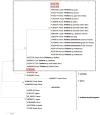Detection of Tick-Borne Pathogens in the Korean Water Deer (Hydropotes inermis argyropus) from Jeonbuk Province, Korea
- PMID: 26537046
- PMCID: PMC4635824
- DOI: 10.3347/kjp.2015.53.5.653
Detection of Tick-Borne Pathogens in the Korean Water Deer (Hydropotes inermis argyropus) from Jeonbuk Province, Korea
Abstract
The objective of this study was to investigate the prevalence of tick-borne pathogens in the Korean water deer (Hydropotes inermis argyropus). Pathogens were identified using PCR which included Anaplasma, Ehrlichia, Rickettsia, and Theileria. Rickettsia was not detected, whereas Anaplasma, Ehrlichia, and Theileria infections were detected in 4, 2, and 8 animals, respectively. The most prevalent pathogen was Theileria. Of the 8 Theileria-positive animals, 2 were mixed-infected with 3 pathogens (Anaplasma, Ehrlichia, and Theileria) and another 2 animals showed mixed-infection with 2 pathogens (Anaplasma and Theileria). Sequencing analysis was used to verify the PCR results. The pathogens found in this study were identified as Anaplasma phagocytophilum, Ehrlichia canis, and Theileria sp. To the best of our knowledge, this is the first report identifying these 3 pathogens in the Korean water deer. Our results suggest that the Korean water deer may serve as a major reservoir for these tick-borne pathogens, leading to spread of tick-borne diseases to domestic animals, livestock, and humans. Further studies are needed to investigate their roles in this respect.
Keywords: Anaplasma; Ehrlichia; Korean water deer; Theileria; reservoir; tick-borne pathogen.
Conflict of interest statement
We declare that we have no conflicts of interest.
Figures



References
-
- Taylor MA. Emerging parasitic diseases of sheep. Vet Parasitol. 2012;189:2–7. - PubMed
-
- Dantas-Torres F, Chomel BB, Otranto D. Ticks and tick-borne diseases: a one health perspective. Trends Parasitol. 2012;28:437–446. - PubMed
-
- Uilenberg G. Importance of ticks and tick-borne diseases of domestic ruminants in Southern Europe. Parassitologia. 1999;41:107–109. - PubMed
-
- Kang JG, Ko S, Kim YJ, Yang HJ, Lee H, Shin NS, Choi KS, Chae JS. New genetic variants of Anaplasma phagocytophilum and Anaplasma bovis from Korean water deer (Hydropotes inermis argyropus) Vector Borne Zoon Dis. 2011;11:929–938. - PubMed
Publication types
MeSH terms
Substances
Associated data
- Actions
- Actions
- Actions
- Actions
- Actions
LinkOut - more resources
Full Text Sources
Other Literature Sources
Medical
Molecular Biology Databases

